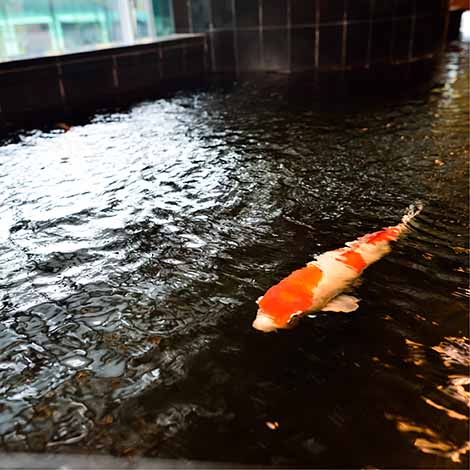No doubt your finned friends will enjoy the cozy indoors during the chilly winter season. Do you have a pole barn? A garage? A basement? An unused outbuilding? These places make perfect indoor places to overwinter your fish. Koi and goldfish begin their wintertime dormancy at about 45 degrees Fahrenheit, so it's best to choose a space that hovers at about this temperature or above. Here's what we recommend.
Lower the Water Level in Your Pond
If you plan to shut-down your water garden, you should drain the water down below the skimmer opening and leave water in the bottom of the pond. The reason for this is to help prevent some shifting within the water garden. The ground will shift throughout the winter and if you were to drain the water garden entirely, it could cause certain sections of the water garden to cave in. Having the water in there will keep everything at bay by applying pressure to all sides. If possible transfer this water directly to your indoor tank for a much smoother transition for your fish from pond to holding tank.
Also, when lowering the water level below the skimmer, make sure to drain the skimmer out entirely. Allowing the water in the skimmer to freeze could cause damage to the skimmer itself. The same goes for the waterfall filter. As for what to do with the pump, store it for the winter in a bucket of water in an area that will not freeze. This keeps the seals on the pump supple and stops them from drying out which can render the pump no longer waterproof. If water gets into the inner workings of the pump it can ruin the pump. This can be a costly lesson in pond maintenance.
Lastly, lowering your pond's water level will make it easier to catch your fish with the least amount of stress for all involved.
The Gear
To prepare your fish's winter home, you'll need some special supplies, including:
- Stock Tank or Holding Tank: The Container you choose to hold your fish should be made of fish safe materials and be cleaned thoroughly before use. This will be your indoor pond area. Because your fish won't be as active they won't need a huge pond to live in, so you can get away with smaller quarters. Choose a tank that's sized appropriately for the number and size of your fish. If you have large koi or a large number of smaller fish a small preformed pond liner would work well. To make the transition easier, use a siphon to fill the holding tank with water from your pond. If you choose to start with tap water make sure to add the appropriate Water Conditioner.
- Pond Netting: The close quarters might surprise your fish and they could try to make a jump for it unless they are used to the change in scenery, so make sure you cover the tank with Pond Netting and secure it with bungee cords or other tie-downs. That will keep them safe and secure.
- Aeration System: Just as you aerate your water garden, you'll need to aerate your holding tank. An energy-efficient aeration kit like the PondAir Aeration Kits are great for indoor tanks.
- Filter: It is important to also filter the water in your indoor tank to keep fish waste under control. AllClear G2 Pressurized Filters allow for easy maintenance and come in a range of sizes that will work perfectly for an indoor tank.
Maintenance
Caring for your fish in their indoor digs is similar to what you do when they're outside. Because the living quarters are cramped, check your water parameters with a test kit once a week or so to ensure the water quality is safe. Also, check your water levels and add water as needed, and keep an eye on the equipment to make sure it's working properly.
- No Chemicals Necessary: Unless your holding tank receives a lot of sunlight, you won't need chemical treatments, like algaecides or water clarifiers. They're not necessary, particularly if you use beneficial bacteria, stress reducer and an aeration system.
- Boost Your Bacteria: Natural beneficial bacteria, like those found in The Pond Guy Liquid Clear, will keep your tank water clean (and give your mechanical filtration system a break!), so pour some into the tank. The tiny microbes activate as soon as they hit the water, multiplying every 20 to 40 minutes and digesting dead organics in the water. The result: crystal clear water and happy fish.
- Condition the Water: A stress reducer, like The Pond Guy Stress Reducer Plus, will help your fish enjoy their indoor stay, too. The water conditioner fortifies your fish's slime coat, which is the natural slime secretion that's lost when its stressed. It also removes heavy metals, chlorine and chloramines from tap water, making it safe for underwater living.
Now that you have everything set up and ready you are ready to transfer your fish to their winter home indoors. Collect them using a fish net and transfer them to the new home using the same acclimation process you would undergo with new fish.
